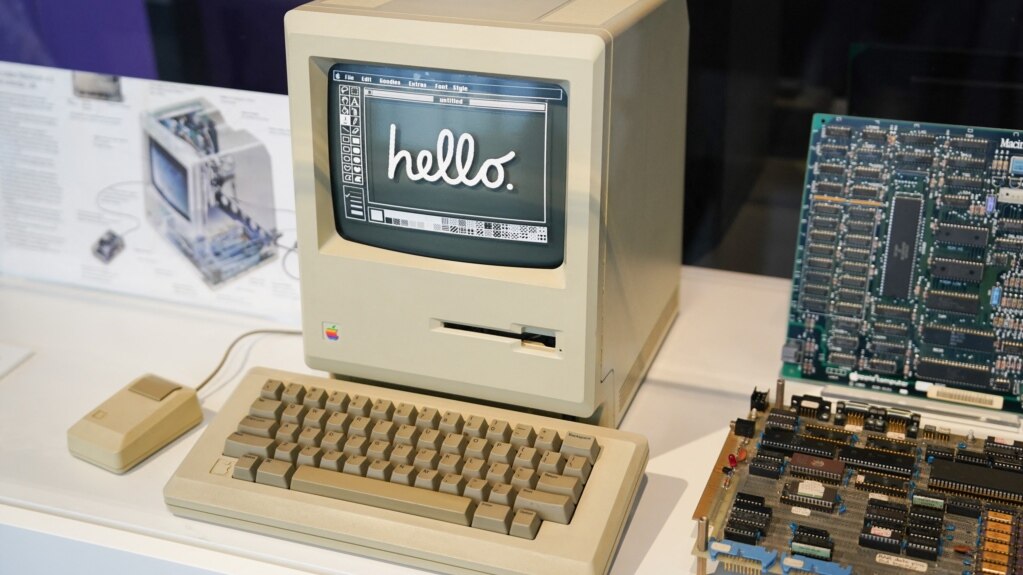Many people first heard about Apple’s Macintosh computer through a television commercial during the American football Super Bowl game in 1984.
However, the commercial did not show a computer at all. It showed a woman throwing a hammer at a large screen. On the screen was a man giving a speech. The screen exploded and an announcer said, “Apple Computer will introduce Macintosh. … And you’ll see why 1984 won’t be like ‘1984.’”
1984 is George Orwell’s book about an authoritarian government. And Apple aimed to tell people that the new computer would be different. It would be easy to use.
Made with humans in mind
Many computers at the time only did one or two things. And they required the user to type complex commands to start the programs.
Jacob O. Wobbrock is a professor of information at the University of Washington. He wrote about Apple’s commercial in The Conversation.
Apple “was selling a product for human beings to use,” Wobbrock writes. After the commercial, he suggests, Apple became known for design and the world started paying attention to the idea of user experience, or human-computer interaction.
“The Macintosh was one of the first products to really prioritize user experience and focus on making something useable and understandable, learnable even guessable. So that people didn’t have to always read a manual to learn how to use it.”
Mackenzie Bristow is a former language teacher and researcher who now works in user experience in Atlanta, Georgia. She said Macintosh was one of the first products to think about “the user.”
“What is the role of the person? What is the role of the user?” she asked. She explained that in design, the rule is “first, understand the person” before thinking about what the product looks like and what it can do.
Forty years after the launch of the Macintosh computer, we now see computer screens everywhere – at restaurants, at airports and even in cars. All of those devices have been designed by experts in user experience.
STEM plus ‘soft skills’
Many colleges and universities now offer study programs in user experience.
While it is part of STEM – science, technology, engineering and math – Wobbrock said students from different areas of study, including psychology or communication, could be successful.
“The kind of student that thrives in user experience is a student who has above all else, a real curiosity about how people interact with technology. … And students whose first language is not English can absolutely do well in user experience.”
One of those students is Kartik Sundaram of India. He studied computer science at the University of Michigan and chose user experience for his graduate study. He finished last year and is now teaching the subject.
“I never felt like I had a personal desire to pursue [computer science],” he said. He called the work “very isolating.” For fun, he took a photography class. While in the class, he met someone who was studying in the User Experience Research and Design program.
“He told me about how, you know, it’s like this blend of design and people and technology, and that kind of lit a fire in my heart to say ok, this seems a lot more interesting, … ‘let’s jump right in, let’s learn more about it and let’s apply to that school.”
Sundaram said user experience is good for people who are “personable and good at making connections.” Some of those are called ‘soft skills,’ he said. And “the soft skills really matter.”
While he grew up speaking English, Sundaram said the world of user experience is more and more open to people who are learning English or who may speak with an accent.
“I don’t think it’s an expectation that your English is flawless,” he said.
Bristow said the ability to speak more than one language “is kind of a super power in user experience,” because those people are comfortable interacting with many different kinds of people. “That’s really something to be celebrated,” she said.
Future of UX and job outlook
Sundaram is teaching but also looking for work in the field. Wobbrock is a professor and Bristow works on training programs for a large company.
They each spoke about the need for user experience professionals to work in the expanding field of artificial intelligence, or AI.
Sundaram said “We’re not going to be restricted to a text box in ChatGPT for much longer. There are going to be other ways to interact with it.”
Bristow said the ability to understand language is important. AI programs will need experts who understand how language changes based on where people live, their level of education and their age.
Wobbrock said user experience professionals are starting to work on projects called human-AI interaction. “There will be a great need for user experience professionals to help understand how people and AI can interact and work together in profitable ways,” he added.
But Sundaram warned that user experience study programs, also known as UX, are becoming very popular. He said some students see UX as a field to make a lot of money with few certification requirements. And several companies are letting go of people with experience in the field.
Sundaram said, “It’s definitely a difficult market, but it’s an incredible field and there are new interfaces coming out that need our work.”
I’m Dan Friedell. And I’m Jill Robbins.

